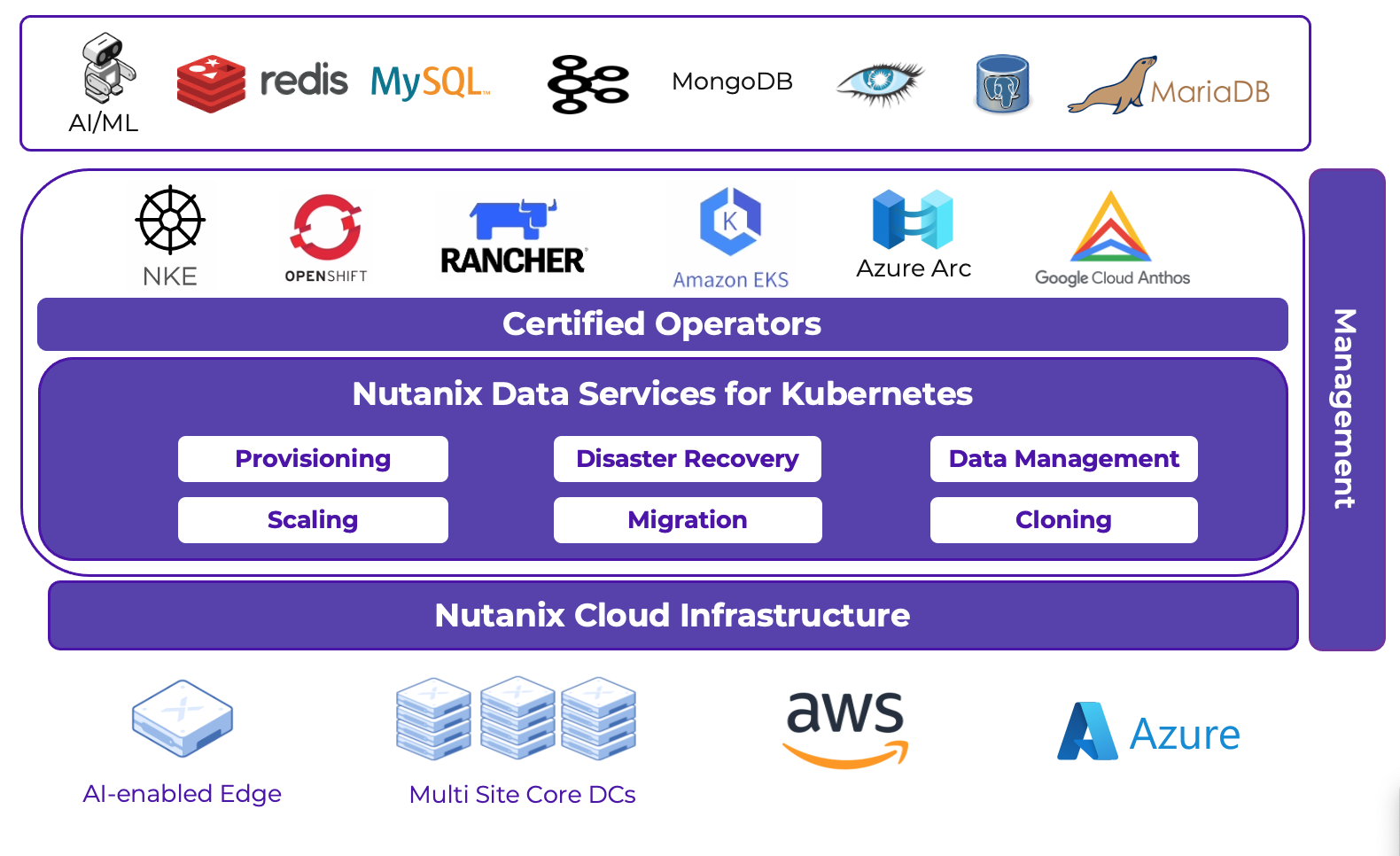Nutanix Announces Early Access of Nutanix Data Services for Kubernetes (NDK)
By Aaron Delp
Today at Nutanix .NEXT, we are announcing Early Access to Nutanix Data Services for Kubernetes (NDK). As the adoption of cloud native applications continues to grow, there is a pressing need to address the challenge of providing application-aware data services for Kubernetes.
Nutanix Data Services for Kubernetes (NDK) simplifies and unifies the entire lifecycle management of business-critical applications by extending enterprise data services to containerized applications. For developers, NDK speeds time to value and reduces operational risk by introducing a cloud operating model. For business owners, NDK increases cost efficiency and simplifies the delivery of resilient infrastructure. NDK will work with most Kubernetes, including our preferred choice for enterprise full stack Kubernetes, Red Hat OpenShift. NDK extends Nutanix and Red Hat joint engineering and provides a seamless support experience.

Accelerate operations with application-level data services
Infrastructure administrators and architects struggle to provision and manage applications as scale and complexity increase. Kubernetes storage drivers today provision and manage at the container level with little to no awareness of the application. Properly managing services at the Application/Namespace level often requires third-party tools that increase time to manage, reducing efficiency, and causing headaches in migration, backup, and data recovery.
With NDK, you can easily manage day 2 operations for the entire application, regardless of location. Compared to existing tools that offer services for storage volumes only, NDK provides data protection, recovery, migration, cloning and copy data management for modern apps on Kubernetes. Nutanix extends data services to create an application-aware solution, reducing recovery time objective (RTO) and recovery point objective (RPO) from days to minutes without the need for Kubernetes expertise.
Deploy NDK with an easy and intuitive three-step model:
- Define the application/namespace.
- Define a governance policy.
- Define the protection plan.
Reduce risk through simplification & unification
The dynamic, distributed nature of Kubernetes can add complexity and risk to operations. One-to-one storage mapping to a container with storage drivers creates an incomplete solution for application-level protection. Application provisioning is difficult at scale, and day 2 operations and monitoring are similarly challenging, leading to a constant challenge that gets more complex as the environment grows. The larger the environment, the more risk encountered.
The easiest way to mitigate this risk is by simplifying and unifying operations at the infrastructure layer. With NDK’s policy-driven management for stateful applications, infrastructure teams easily abstract multiple Kubernetes clusters and Nutanix storage services into a single management plane to ensure application governance and standardization. NDK unifies application/namespace level monitoring, capacity planning and role-based access control (RBAC) with one dashboard, Prism Central. See for yourself:

Managing policies and quotas in nutanix projects

Kubernetes clusters view with resource consumption
Enable cloud operating model
Kubernetes Administrators and Developers require automation through APIs for on-premises infrastructure to operate similarly to the public cloud. NDK extends existing Kubernetes CLI (kubectl) and APIs, removing the need for additional training & tools.
In addition, traditional legacy infrastructure often doesn’t allow for role-based delegation and developer self-service of modern applications. Organizations require the ability to automate operations & location transparency. NDK solves these issues by:
- Delegating infrastructure responsibility to Kubernetes and IT admins with policy-based guardrails.
- Enabling self-service workflows to eliminate the dependency on provisioning infrastructure that increases application deployment velocity by creating governance policies for operations and data protection.
- Providing application/namespace mobility from on-premises to the cloud without the complexity of multiple tools, synchronization, and manually restoring container and application/namespace metadata.
Increase cost efficiency
Cost-efficient operations are increasingly paramount. A lack of visibility into current and future resource consumption leads to wasteful expenditures and mismanaged infrastructure budgets. Organizations today struggle to properly implement modern applications cross-cloud, wasting time and budget.
Nutanix lowers management costs by simplifying the operations of cloud native applications at the container, namespace, and application levels. NDK abstracts away infrastructure complexity, on-premises and in the cloud. Remove the risk, optimize resource allocations, and save money through streamlined operations.
Next steps
For more information including how to participate in our NDK Early Access Program, please see our Cloud Native Solutions page.
© 2023 Nutanix, Inc. All rights reserved. Nutanix, the Nutanix logo and all Nutanix product, feature and service names mentioned herein are registered trademarks or trademarks of Nutanix, Inc. in the United States and other countries. Other brand names mentioned herein are for identification purposes only and may be the trademarks of their respective holder(s). This post may contain links to external websites that are not part of Nutanix.com. Nutanix does not control these sites and disclaims all responsibility for the content or accuracy of any external site. Our decision to link to an external site should not be considered an endorsement of any content on such a site. Certain information contained in this post may relate to or be based on studies, publications, surveys and other data obtained from third-party sources and our own internal estimates and research. While we believe these third-party studies, publications, surveys and other data are reliable as of the date of this post, they have not independently verified, and we make no representation as to the adequacy, fairness, accuracy, or completeness of any information obtained from third-party sources.
This post may contain express and implied forward-looking statements, which are not historical facts and are instead based on our current expectations, estimates and beliefs. The accuracy of such statements involves risks and uncertainties and depends upon future events, including those that may be beyond our control, and actual results may differ materially and adversely from those anticipated or implied by such statements. Any forward-looking statements included herein speak only as of the date hereof and, except as required by law, we assume no obligation to update or otherwise revise any of such forward-looking statements to reflect subsequent events or circumstances.